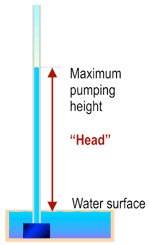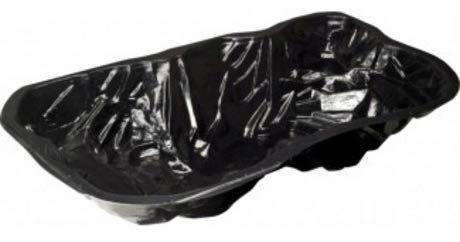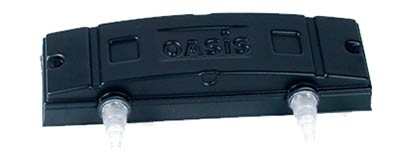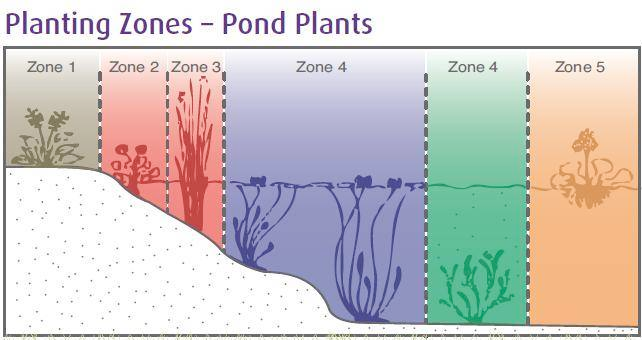
Maximum pump head measures the vertical distance from the surface of the pond water to the point at which the water enters the water course.
Maximum head height refers to the maximum pumping height of the pump.
The stated head height of a pump is the minimum height at which there is zero flow. A pump with a 3 m head will have zero flow at 3 m.
It is important to know the height of your intended water feature. If you need 2000 L of water to run your water feature, then you must ensure the pump that you select can prompt 2000 L of water at the height of the feature.
Head height can be misleading, many by the wrong size pump, so it's important to know how much water the pump can handle at different practical heads or height differences. Pump flow rates for varying head heights are provided on this website for reference.
Total dynamic head
Other information required to calculate the total dynamic head (TDH) includes the length and diameter of the pipe leading from the pump to the outlet at the top of the water course. Working out friction losses due to varying hose sizes and types and the number of joints is very complex.
For most garden ponds allow 10 cm of lift for every 1 m of hose length e.g. every 5 m of tubing adds 50 cm to your head height calculations. Any elbow or T-pipe will substantially reduce the flow. (25% of height for each 90° elbow), so where possible, use flexible tubing to curve around corners.
Tubing/flow rates
The hose size running from the pump is determined by the maximum flow rate of the pump selected. When selecting hoses, select the diameter that is as large as possible to avoid excessive friction losses.
How to measure flow rate
This is helpful to see if an old pump is still working effectively as it may need cleaning or replacing.
Take a container of a known volume e.g. a 5 gallon bucket, and time how long it takes to fill it in seconds at the flow you have, then divide by 3600 the number of seconds it takes to fill the container. Then multiply by the volume (gallons of the container), the result equals the flow rate in gallons per hour.
e.g. If it takes 10 seconds to fill a 5 gallon bucket;
3600/10 seconds x 5 gallons = 1,800 GPH
(For metric conversion GPH x 4.54 = LPH)
You can use this formula to find how much will you would like over the garden waterfall, by placing a garden hose at the top of the waterfall and adjusting the volume of water until you find the flow that you want.
Measure this flow to give you an idea of the volume required to get the effect you desire, for strong flows multiple hoses will be required.
Using all of these calculations you should be able to determine any requirements for pumps and filters.
What size pump do I need?
The pump is one of the most important equipment purchases you will make.
Use flow rate and had pressure to select your water pump.
You must know:
The volume of water that you will move through your system i.e. volume of the pond or water feature and filters combined.
How many times per hour you need to calculate the volume of your pond. Typically 1 to 2 times the volume per hour depending on fish stocking densities.
How much resistance (head) the pump encounters as it moves water from the pond surface to the point where the water enters the water course.
There are three main types of pond pumps according to their use:
Filter
Fountain
Water course
 Filter pump selection
Filter pump selection
In order to select the optimal filter size, first upon volume must be calculated.
Rectangular/square ponds
Length M (A) x Width M (B) x Average depth M (C) x 1000 = approximate volume in litres.
Circular ponds
1/2 A x 1/2 A 3014 x Av Depth x 1000 = volume in litres
NOTE: Taking the average depth may involve 10 different measurements to give an average pond depth.
Once your calculations have been made, always select the pump with slightly more capacity than you require. NOTE: the filtration system needs to circulate the total effective pond volume every 1 to 2 hours.
Matching your pump to your filtration system
If you have chosen to keep your pond clean with a biological filter (pressure of gravity filter) then you must size your pump appropriately for the filtration system. If you don't have enough flow through your filter, it will not circulate the pond water often enough and therefore your filter will not clean your pond correctly. However, too much flow through your filter will result in water passing through the filter too quickly, often bypassing the filter material and giving the UV clarifier no chance to kill algae, this rapid flow can result in a cloudy pond and can cause filter damage.
In many situations separate pumps should be used for the filtration system and water feature, since bio-filters need to run 24/7 (to maintain oxygen levels and healthy filter bacteria). Other features such as waterfalls and water features do not need to run all the time.
Improve the performance and longevity of your pump
Do not shorten electrical cable as it will invalidate the manufacturers warranty.
Position the pump off the pond floor and away from silt.
Regularly cleaned the impeller i.e. every six months.
Do not restrict the flow of water from your pump - select appropriately sized hose for the size of pump.
Do not run the pump dry.
Regularly clean the pre-filter
Do not bury transformers in the ground.
Watercourse pump size calculation
As a rule of thumb for determining the right pump for water course use the following:
Width of watercourse in centimetres times 1.5 litres/min equals capacity in litres/min.
This watercourse pump can either be a pond filter pump or upon the fountain pump depending on the size of the watercourse and the degree of cleaning required. Ideally use of pond filter pump as they have the highest flow rates and require less cleaning.
Fountain/waterfall pump
(i.e. combined general-purpose pumps)
All round garden pumps which are designed to operate fountains, waterfalls and even filters simultaneously. They are usually supplied with a variety of Fountain jets and most have a foamless pre-filter for reduced maintenance.
This pump is perfect for most small to medium-sized ponds. The height and spray pattern (i.e. droplet size) is important, as finer droplets will absorb more oxygen and a higher spray will also absorb more oxygen. Foam jets are the most effective at this, however, they require more power to run (in general the more powerful pump motor, the more oxygen dioxide the spray can absorb).
The pre-filter in these pumps prevents the small holes in the fountainhead blocking with debris.
Always choose a fountain pump that comes complete with various fountainheads as well as a valve which allows water to flow to a bio-filter.
Maximum Fountain height
Minimum distance to the nearest edge of the pond. If the fountain is too high, water will be lost from the pond with splash and even worse in windy conditions.
Feature pumps
A small pump designed to operate in small self-contained water features. They are not really suitable for use in a garden pond due to the size of pre-filter, most models will have a flow control to reduce flow rate by approximately 25% plus a range of selected Fountain attachments.
Filter/watercourse pumps
These are designed to allow larger soft solids to pass through the pump so that the waste is delivered to the filter, where it is trapped. Also ideal for watercourses as they rarely block or need maintaining. Due to the pump design they are not suitable for running fountains. Often two pumps are beneficial, one of these to run the bio-filters 24 hours a day and a fountain pump to operate the fountain which can be switched off at certain times.
Solar powered pumps
Powered by a solar panel they are usually small feature/fountain pumps.
All in one pumps
This type of pump combines a biological filter and ultraviolet clarifier in an integrated unit, suitable for small ponds with low stocking levels of fish.
Pump selection and installation tips
Decide on your requirements before choosing a pump.
Always select the pump with extra capacity i.e. never purchased a pump which is just powerful enough.
If only running of filter, select a solid handling pump.
Always use the recommended hose size for the pump. Use the largest diameter holes on multistage pose tales when possible, always cut off horsetails to the correct size.
Always use an RCD trip switch
Always use a qualified electrician for the installation of electrical equipment.
Position the pump to maximise circulation off the pond floor, on a stone, away from silt.
For small or large ponds the unit is housed outside of the pond, usually by the top of a waterfall. A surface or submersible pump is used to push water through the filter medium.
Which biological filter?
Low Fish Stock
For ponds which have mainly plants and no (or few) fish and normal levels of sunlight.
High Fish Stock
For ponds with less plants and a higher stocking level of fish or exposed to high levels of sunlight.
Different types of filter
Most are available with combined UV clarifier.
Complete pond filter systems (all in one filters).
These are basic filters which are positioned in the pond, usually used only in small ponds that are lightly stocked with fish, these incorporate a pump, filter and UV clarifier in one easy to install unit. The drawback with this type of filter is that water circulation tends to be more uneven.
Pressure filters
Ideal for small to medium sized ponds they are directly fed from a pump in the pond. Since the filter is a sealed unit, the water leaving this unit is still under pressure, allowing more flexibility in positioning of the unit. Due to their small size, choose the one with a cleaning mechanism to reduce the opening up and maintaining of the filter.
Flow through filters
These filters are pump fed and gravity return, they require a pump in the pond to feed the filter. Water will pass through the filter and return to the pond through gravity. The filter outlet must be higher than the point at which you want the water to return.
Therefore it is important to consider installation options before selecting such a filter.
Gravity fed filters
These are usually only used it the pond has been specially constructed with a sloping base and bottom drains. The filter must be sunk into the ground so the water level in the filter is the same as the pond. Water enters the filter by gravity from the pond’s bottom drain and is returned by the pump under pressure. This type of filter can be used to power a Fountain Jet, or waterfall if required.

Therefore
The choice of your pond filter should be based on the size of the pond, the number and type of fish, and the area available for installation of the filter.
Pond size
Work out the volume of water in your pond.
Multiply the average length x average width x average depth
Multiply this figure by 1000 to get the volume in litres
When calculating pond dimensions in feet, convert this measurement to gallons by multiplying by 6.23
Which UVC filter?
You will need to know your pond volume to choose a suitable UVC.
To find the correct UVC for your pond, also consider the stocking and sunlight levels. If either of these are high, always pick the UVC based on the high fish/sunlight level rating.
Calculate the right UV clarifier power
Pond without fish stock 1 WUVC power per meter cubed of pond volume.
Pond with fish stock 2 WUVC power per meter cubed of pond volume.
Pond with koi stock 3 WUVC power per meter cubed of pond volume.
UVC bulbs should be changed in spring to guarantee full strength capacity of UVC lightwaves.
Installing a biological filter
Gravity return biological filters have a gravity outlet. The outlet must be higher than the point of return.
To maximise water flow, and ensure the largest possible inlet is used.
Gravity outlet filters, keep the return pipe full bore, gently sloping down and as short as possible.
Most top outlet filters work better if partially buried, keeping the sides tight around the media when full of water.
Running a biological filter
Filters must be run 24 hours a day (certainly from March to October).
Pass your pond water volume through the filter at least every 1 to 2 hours.
Regularly check pump pre-filter to ensure a good flow.
Remember a filter can take up to 6 weeks to fully biologically activate.
Clear water does not mean healthy water, test your water regularly.
Use a bacterial supplement to kickstart and improve filter performance. At this point have UVC off to avoid any ? effect.
Always clean filter material in a bucket of pond water and not in tap water.
Only clean media when flow is being restricted.
Pond Aeration
Barometric pressure, altitude, salinity, water purity and biological oxygen demand or affect the amount of naturally occurring dissolved oxygen levels in water. The amount of additional oxygen water can hold through the aeration process is a function of temperature, altitude, and salinity. Colder water holds more oxygen than warm, water in higher elevations or with higher salinity levels has a decreased saturation level of oxygen. Once you have reached the saturation level, oxygen cannot be added without the help of photosynthetic activity or the introduction of pure oxygen.
In ponds, the introduction of oxygen via some type of aeration device can:
Allow for greater densities of fish
Speed up the rate of organic decomposition
Improve overall water quality
Reduce the amount of phosphorus, which would otherwise be available for plant growth
Decrease the severity of algae blooms.
Note: There are a number of types of aeration devices available in our pond aeration section.













